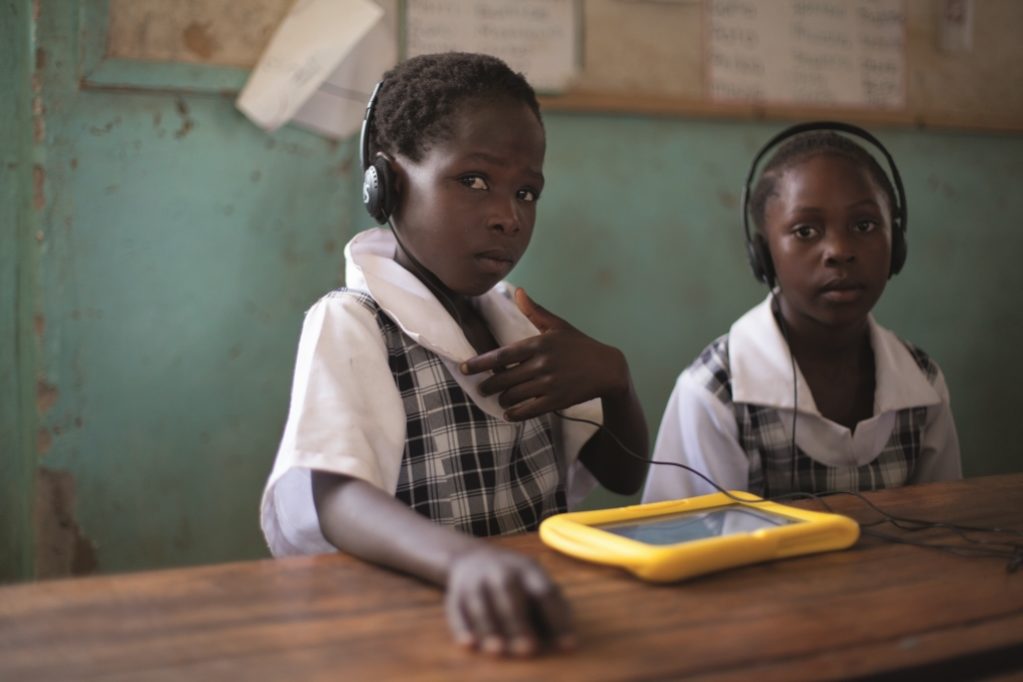It’s curious, and almost incongruous, to see Juste Chisenga, the Grade 1B teacher at the Kasisi Primary School, give a lesson in a neat black suit and checkered tie in the Zambian language of Bemba.
It’s hot and sweaty under a rusted tin ceiling that has been around since 1924. The classroom walls are full of cracks and its light blue paint is peeling. Dozens of curling educational posters hang, yellowed with age.

The children look as worn out as the building they are in. Some have walked as far as 14 kilometers to get here. Their uniforms are mismatched and layered in red dust.
This is the last place you would expect to see a teacher wearing a suit. Chisenga looks like a man from another time.
It’s also the last place you would expect to see children staring at a slideshow on a solar powered projector instead of a blackboard.
It’s even more bizarre seeing the same seven-year-olds sitting on uneven wooden desks and pulling out several smart tablets from a cardboard box to continue their lesson.
This is the brainchild of entrepreneur Mark Bennett. His idea is to help educate young Zambians by making a tablet part of their school curriculum for their villages.
“We decided to do something about the way teaching is done in Zambia… These days everyone has access to a cell phone. What’s more, in the rural areas they know how to work it; without being able to read. So we designed something that could be translated into several different languages… We’ve spent around $6 million developing the software with the help of 250 designers from around the world animating it. So far, we have had 2.3 million words translated into local languages and a quarter of a million sounds,” he says.
Bennett first came to Zambia in 1985 on a two-year contract to work at a computer center at the University of Zambia. He left the job twelve years later after the university figured out he was still on its payroll, he jokes. From there, he spent years bringing the internet to Zambia. He became a household name when he sold his Zambian internet service provider, AfriConnect, to Vodacom in 2005.
Wondering what to do next, Bennett’s idea for iSchool came seven years ago while sitting next to Clare Stead on a plane.
“We started by asking what would we do in education differently in the bush. What would you do to teach better,” says Stead, who is now the E-Learning project director for iSchool.
“The internet is a great learning tool but not for Africa. It’s not contextual. We found that children in rural areas didn’t understand why Elmo from Sesame Street would need to hang washing up between two skyscrapers in Seattle. Our first step was designing an education program suited for the rural people of Africa,” she says.
With overwhelming class numbers of between 60 to 100 children at a time, teachers in Africa are overworked, underpaid and lack organization, says Stead.
“With the ZEduPad, children can engage with the tablet and find answers faster than a teacher asking the same question 60 times over. We were also able to devise a curriculum plan for teachers to help them set goals for the week, for the month and for the whole year.”
It’s not always been smooth sailing. The team has encountered a number of hurdles including the Zambian government that passed a law to allow children to be taught in their mother tongue. It meant Bennett’s team had to write out whole new languages, including the first dictionaries for a number of dialects.
Regardless of the difficulties, Bennett remains resolute. Now in its second year, the project has distributed 7,000 tablets across Zambia.
The tablets are solar charged meaning they can go pretty much anywhere in the county, says Bennett. The children find them fun to use and, thanks to the language changes, easily understood. It makes learning easier than staring at a blackboard and far more interactive, says Stead.
The results according to teacher Chisenga have been amazing. His grin is as wide as the tablet he helps his grade ones complete their basic maths with. A man in a suit that looks as out of place in the classroom as the tablets.
